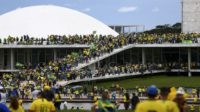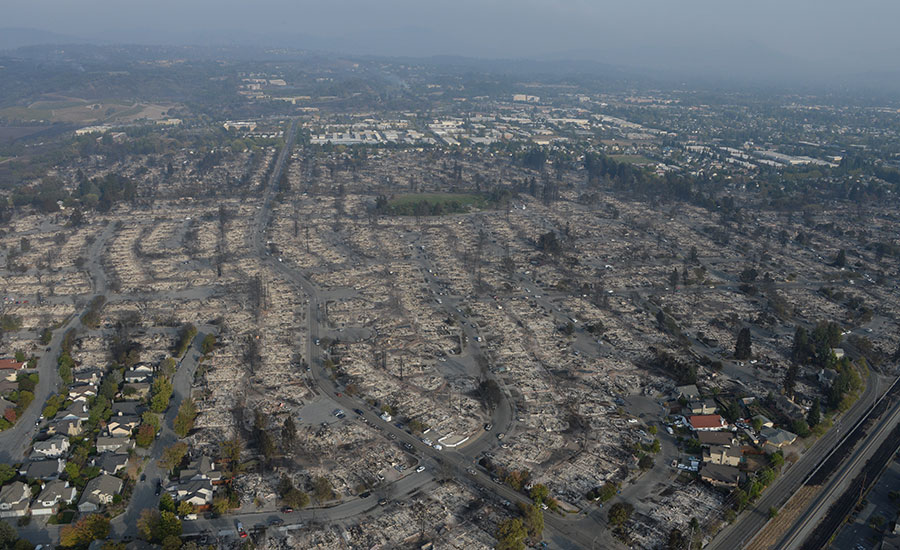Architects Come Together to Assess Losses, Aid Communities After California Fires

The neighborhood of Coffey Park (seen here on October 17) was one of the hardest hit in Santa Rosa, California. Throughout Sonoma County, 23 people lost their lives and some 6,700 structures were destroyed.
Photo by Sgt. 1st Class Benjamin Cosse, © California National Guard

National Guard helicopters surveyed and dropped water on the fires in and around Santa Rosa, California, seen here on October 11, 2017.
Photo by Master Sgt. David Loeffler, © California National Guard

Architects staffed the AIA table at the FEMA center in Santa Rosa, California.
Photo © Julia Donoho

The Fountaingrove Round Barn, built in 1899 in Santa Rosa, California, was destroyed on October 9, 2017.
Photo © Frank Schulenberg




At FEMA’s local assistance center in Santa Rosa, California, which just opened last week, architect volunteers explain the process of rebuilding (and negotiating with insurers) to people who have never built a home before. “We’re going to have a separate ‘speed dating’ event for those whose original architect isn’t available, so they can get their plans sooner than later,” says Julia Donoho, chair of the AIA Redwood Empire’s Firestorm Recovery Committee, which was first formed in response to the 2015 Valley Fire in nearby Lake County.
In a state that is accustomed to wildfires, the recent blazes in Northern California have been shockingly destructive, causing 42 fatalities and obliterating a record-shattering number of properties. In the mid-sized city of Santa Rosa alone, an estimated 2,800 properties were destroyed, including entire neighborhoods, schools, and commercial buildings, along with a rare 1899 round barn. Collectively, fires across eight counties have claimed an estimated 7,500 properties. The bulk of the losses have been in Sonoma County; a reported 600 properties were destroyed in neighboring Napa County.
The region’s hilly landscape of oak woodlands and vineyards, located within easy driving distance from San Francisco, is a prized setting for dream homes. News is still trickling out, but one of the most high-profile residence lost to the fires is the “Glass House,” designed in 2003 by Helena Arahuete, a longtime associate of John Lautner. The 13,500-square-foot, glass-walled house occupied a private mountaintop in Fairfield. Napa Valley architect Howard Backen, whose reclaimed-wood barn aesthetic has had a major influence on the local vernacular, lost a residential project in Sonoma. A house clad in corrugated steel designed by San Francisco architect Jim Jennings was destroyed along with the rest of the buildings at Mayacamas Ranch, a retreat center in Calistoga. And the San Francisco firm Aidlin Darling lost one home in Sonoma and another under construction in Napa.
A possible culprit for the fires has already turned up: power lines downed by seasonal high winds. Cognizant that climate change makes wildfires more likely, architects are analyzing surviving and downed buildings for guidance. Napa architect Juancarlos Fernandez speculates that the combination of a metal roof and fire-resistant vents warded off flying embers from a wood-clad home he designed. Another local practitioner, Brandon Jorgensen, is advocating for designs that do away with roof vents entirely and protect crawlspace vents; he is organizing a symposium of notable architects to explore best practices for resilient buildings. “We need to put together proposals that are holistic, from the landscape all the way to the assembly,” he says. California’s Wildland-Urban Interface (WUI) building code does have significant fire safety requirements for construction in fire hazard zones, which cover a good chunk of the region. But it’s worth noting that some of the affected areas were in moderate fire risk zones, or even outside the hazard zones entirely.
Donoho’s committee is currently focused on initiatives to quickly house the many people who are now homeless. They’re hoping to streamline the city’s process for getting an accessory dwelling unit (ADU) built; create a temporary village of modular houses; and set up an organization to rebuild the tract-home neighborhood of Coffey Park wholesale instead of piecemeal.
“It’s been a huge loss architecturally,” says Donoho, commenting on the widespread destruction. It’s important to start the rebuilding soon, she says, to keep the community intact. “From trailer parks to tract homes to multimillion-dollar homes, there’s every kind of project for people to work on here.”





